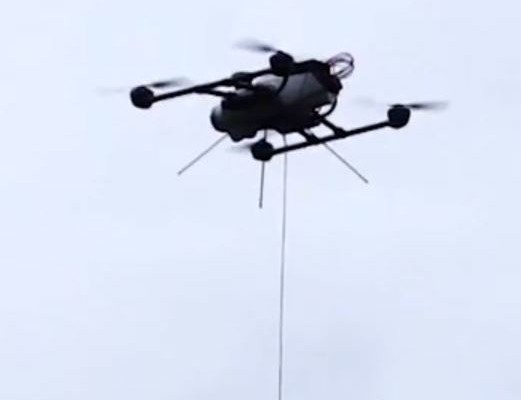Before the FAA’s Rule 107 allowing UAS use for commercial work, we waited patiently (and often impatiently) for the day when UAS would be “unleashed.” Ironically, now a new class of UAS gets its power from actually being on a leash. Tethered drones use a hardware tether (as thin as a headphone cord) from the ground to the craft to provide continuous power and a constant video feed.
Powering both the drone and its sensors from the ground has a number of advantages. For one, flight time is extended from less than an hour (with most current UAS) to days. Additionally, a tether can supply more power than a battery, which means larger motors and heavier payloads.
Naturally, there’s a downside to tethering: lack of maneuverability. Tether lengths range from 200’ to 400’ depending on the provider. Still, in many applications their ability to provide long duration imagery offers a valuable resource. Here are some examples.
First responders: the New York City Fire Department used Hoverfly’s LiveSky to fight a major fire in the Bronx last March. By giving firefighters a bird’s eye view of the fire with high-resolution color and thermal infrared imagery, NYFD staff could monitor the fire and determine areas for safe access.
Disaster recovery: floods, tornadoes, earthquakes, and all types of disaster recovery efforts can benefit from this technology to provide long-duration situational awareness.
Military and law enforcement: surveillance and monitoring are strong applications for drone tethering.
Construction monitoring: keeping an eye on the progress of construction projects for extended periods of time could be a good use for tethered drones.
Telecommunications: AT&T recently tested a tethered drone as a cellular telephony repeater. This would be ideal for creating temporary cellphone networks over disaster recovery areas and for events in remote areas where cell coverage is weak or nonexistent. For smaller applications, even among survey crews for example, goTenna Pro offers a self-healing, self-defined, mobile ad-hoc networking communications solution that allows the use of a drone as a repeater-in-the-sky.
Players: in addition to Hoverfly mentioned above, CyPhy, elistair, and PowerLine provide tethered UAS technology. CyPhy offers its PARC, persistent aerial reconnaissance and communications UAS, while PowerLine applies the tethering concept to DJI’s Inspire 1 UAS, and elistair (shown above) offers tethering options for a wide range of UAS including DJI, Aerialtronics, Yuneec, and others.
As cool as tethering is, wouldn’t it be awesome to have a way to power a UAS from the ground for long duration flights without the restrictions of a tether? Stay tuned next time for a next-gen technology that promises just that!

